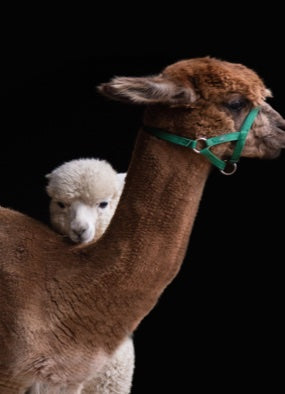
The Different Types of Alpaca Fiber: Regular, Superfine, Baby, and Royal Alpaca
Alpaca fiber is renowned for its softness, warmth, and luxurious feel, making it one of the most sought-after natural fibers in the textile world. However, not all alpaca fiber is the same. Depending on the fineness and quality of the fiber, there are four main categories: regular alpaca, superfine alpaca, baby alpaca, and royal alpaca. Each type has unique characteristics that make it suitable for different purposes. Let’s explore the differences between these fibers and why alpaca is such a versatile material.
What Makes Alpaca Fiber Unique?
Alpaca fiber stands out due to its softness, durability, and hypoallergenic properties. Unlike sheep's wool, alpaca fibers contain no lanolin, making them a great choice for people with sensitive skin. Alpaca wool is also warmer and lighter than traditional wool, and it has moisture-wicking properties, keeping you dry and comfortable in various climates. The specific types of alpaca fibers are classified by their diameter and fineness, ranging from durable fibers to ultra-luxurious varieties.
Regular Alpaca Fiber

Regular alpaca fiber, often referred to as "adult alpaca," is the coarsest of the four categories but still softer and warmer than other natural fibers like sheep's wool. With a diameter ranging between 26 to 30 microns, regular alpaca fiber is durable and ideal for everyday use in items such as blankets, outerwear, and sweaters. Despite being the most common type, regular alpaca retains alpaca's excellent insulation and hypoallergenic qualities.
Superfine Alpaca Fiber

Superfine alpaca, with fibers measuring between 22.5 and 26 microns, offers a balance between softness and durability. This type of alpaca fiber is perfect for creating garments like scarves, gloves, and knitwear, where both comfort and longevity are key. Superfine alpaca maintains alpaca’s moisture-wicking abilities, making it ideal for winter accessories.
Baby Alpaca Fiber

Don’t let the name fool you—baby alpaca doesn’t exclusively come from young animals. Instead, it refers to the fiber’s fineness, typically measuring between 20 and 22.5 microns. Typically, this fiber is harvested from younger alpacas. Baby alpaca wool is incredibly soft and is often compared to cashmere for its luxurious texture. This makes it an excellent choice for items worn close to the skin, like sweaters, shawls, and hats, offering both warmth and lightweight comfort. Wanna see our Baby Alpaca Collection? Click here.
Royal Alpaca Fiber

The crème de la crème of alpaca fiber, royal alpaca is the rarest and finest of all, with fibers measuring under 20 microns. This ultra-soft and silky fiber rivals the softness of even the most luxurious materials, like silk and vicuña. Given its exceptional quality, royal alpaca is often reserved for high-end luxury garments and exclusive fashion pieces. The fine, delicate nature of royal alpaca makes it feel incredibly gentle on the skin, making it the ultimate choice for those seeking the most luxurious alpaca fibers.
Comparing Alpaca Fiber to Sheep’s Wool
Alpaca fibers are known for being softer, lighter, and warmer than traditional sheep’s wool. They also have less prickle, making them a better option for sensitive skin. Additionally, alpaca fibers are stronger and more durable, with natural elasticity that makes them perfect for long-lasting garments.
Why Alpaca Fiber is Special
Alpaca fibers are more than just luxuriously soft. Their hypoallergenic properties and sustainability make them an eco-friendly option for fashion and home textiles. The fibers resist pilling and maintain their shape, meaning garments crafted from alpaca wool, like baby alpaca and royal alpaca, can last for years with proper care.
Frequently Asked Questions
What is the softest type of alpaca fiber?
Royal alpaca is the softest type of alpaca fiber, with a diameter under 20 microns, making it feel incredibly silky and luxurious.
Is baby alpaca softer than cashmere?
Yes, baby alpaca wool is often compared to cashmere for its luxurious feel, though some consider it slightly softer due to its unique fiber structure.
How is royal alpaca different from regular alpaca?Royal alpaca is significantly finer, with fibers measuring under 20 microns, making it softer and more delicate than regular alpaca, which ranges from 26 to 30 microns in diameter.
What is a Micron?
A micron, also known as a micrometer, is a unit of measurement that equals one-millionth of a meter, or 0.001 millimeters. It is commonly used to measure the diameter of natural fibers, such as alpaca, wool, and cotton. Fiber fineness is often described in microns, with smaller numbers indicating finer and softer fibers.
Why Are Microns Important for Fiber?
The micron measurement is crucial because it directly affects the feel and comfort of a fabric. Fibers with a smaller micron count are softer and more luxurious, making them ideal for garments that come into contact with the skin. For example, royal alpaca has a micron count under 20, making it one of the softest fibers available, while regular alpaca ranges between 26 and 30 microns.
How Does Micron Count Affect Durability?
While finer fibers (low micron count) are softer, coarser fibers (higher micron count) tend to be more durable. This is why higher-micron fibers like regular alpaca or wool are often used in items like blankets and outerwear that need to withstand wear and tear.


